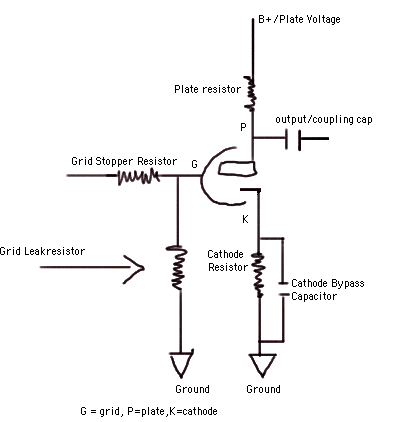
Here are a few terms that you may see online when referencing tube schematics. Like distortion pedals, tube circuits seemingly have their own language! I present this knowledge in the hopes that it may help you decipher the interesting life of tubes! :-) Below, I show a picture and a very simplistic view of a tube stage. The links refer you to the excellent site of Aiken Amps and the wonderful tube glossary!

As you can see above, in this tiny snippet of a tube schematic, the terms you commonly see are there in this triode stage example.
Plate - the plate is usually connected to a plate resistor which is usually connected to the B+ or power supply voltage. Very similar to a FET drain or bipolar transistor collector. Typical Plate Resistor values are 100K, 150K, 220K. Larger values equal more gain.
The Grid is where the signal enters the tube. Very similar to a FET gate, or bipolar transistor base.
The Cathode is usually connected to a cathode resistor which usually goes to ground. Very similar to a FET source or bipolar transistor emitter. The cathode resistor along with the Plate resistor control the gain of the tube stage. Typical values are anywhere from 100 ohms to 10K. Smaller values = more gain.
It is common to see a cathode bypass cap connected in parallel with the cathode resistor. By altering the values of the cathode resistor and cathode bypass cap, it is possible to roll off various degrees of bass with this triode stage. The cathode resistor and plate resistor control the biasing of the tube. The cathode bypass cap also gives the stage more gain.
Sometime you see a capacitor in parallel with the plate resistor, much like the cathode resistor bypass cap. It is usually a small value (i.e. .001uF) and it rolls off highs in the stage. Sometimes you see a high frequency roll off cap as going from the plate pin to the cathode pin - 350pf->500pf in value.
You will also see a coupling cap in between triode stages. The coupling cap controls the bass and rolls off bass between stages and blocks DC from entering the next stage - which could throw off the bias on the next tube stage. As usual, smaller values roll off more bass, larger values retain more bass between stages.
Another modification you may see is a Grid Stopper Resistor, this can also control gain between stages and also interacts with the tube to roll off highs. Values can be 1.5K->100K. Larger values roll off more highs and reduce gain between stages. The Grid Stopper Resistor works best when mounted directly or as close as possible to the grid pin.
"Complete" typical tube preamp stage:

The grid ("leak") resistor, typically sets the impedance of the stage and biasing. It is interesting because it and the previous stage's plate resistor form a voltage divider on the signal. What this means to you is that the grid leak resistor can be used to control the level into the stage. Low grid leak values will attenuate the signal into the tube stage. If you look at different tube amp schematics, you can see where they control the level into the stage by using different values for the grid leak resistor. There is a maximum value that you need to adhere to. Check the datasheet for the tube you are using to see the typical value of the grid leak resistor. This particular circuit is called cathode bias which you can read about here.
In sumary:
The cathode resistor, plate resistor and grid resistor, determine the biasing of the tube stage. The cathode bypass cap controls the degree of bass reduction - generally 25uF passes all frequencies - commonly used in Fender amps, 1uF less, .68uF is used in Marshall amps. A capacitor can be placed in parallel with the plate resistor to roll off highs and you see this in bass channels of amps sometimes. The plate receives the voltage from the power supply through a plate resistor, the grid receives the AC signal as input and the cathode is grounded through a cathode resistor.
There is a lot more, check out Aiken Amps for lots of info and links to ther places. Summit amps has a "how tubes work" paper. Finally check out the GEO Tube Amp FAQ and Tube Debugging page. Fantastic!
Now go to AMPAGE and see how much more you understand!
Tips for fine tuning your amp:
These are very simplistic mods you can do to your amp, let your ears be your guide: